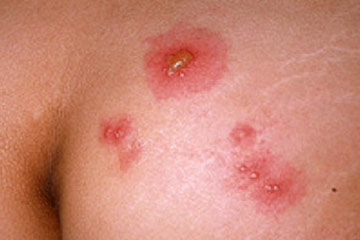Malaria Chemoprophylaxis
All recommended primary chemoprophylaxis regimens involve taking a medicine before, during, and after travel to an area with malaria. Beginning the drug before travel allows the antimalarial agent to be in the blood before the traveler is exposed to malaria parasites. In choosing a chemoprophylaxis regimen before travel, the traveler and the travel health provider should consider several factors. The travel itinerary should be reviewed in detail and compared with the information on where malaria transmission occurs within a given country, to determine whether the traveler will be traveling in a part of the country where malaria occurs and if antimalarial drug resistance has been reported in that location. Additional factors to consider are the patient’s other medical conditions, medications being taken (to assess potential drug interactions), the cost of the medicines, and the potential side effects. Table 3-09 lists some of the benefits and limitations of medicines used for malaria chemoprophylaxis; additional information about choosing a malaria chemoprophylaxis regimen can be found at www.cdc.gov/malaria/travelers/drugs.html.
The resistance of P. falciparum to chloroquine has been confirmed in all areas with P. falciparummalaria except the Caribbean, Central America west of the Panama Canal, and some countries in the Middle East. In addition, resistance to sulfadoxine-pyrimethamine is widespread in the Amazon River Basin area of South America, much of Southeast Asia, other parts of Asia, and in large parts of Africa. Resistance to mefloquine has been confirmed on the borders of Thailand with Burma (Myanmar) and Cambodia, in the western provinces of Cambodia, in the eastern states of Burma on the border between Burma and China, along the borders of Laos and Burma, the adjacent parts of the Thailand-Cambodia border, and in southern Vietnam. The resistance ofP. vivax to chloroquine has been confirmed in Papua New Guinea and Indonesia.
In addition to primary prophylaxis, presumptive antirelapse therapy (also known as terminal prophylaxis) uses a medication toward the end of the exposure period (or immediately thereafter) to prevent relapses or delayed-onset clinical presentations of malaria caused by hypnozoites (dormant liver stages) of P. vivax or P. ovale. Because most malarious areas of the world (except the Caribbean) have at least 1 species of relapsing malaria, travelers to these areas have some risk for acquiring either P. vivax or P. ovale, although the actual risk for an individual traveler is difficult to define. Presumptive antirelapse therapy is generally indicated only for people who have had prolonged exposure in malaria-endemic areas (such as missionaries, military personnel, or Peace Corps volunteers).
The medications recommended for chemoprophylaxis of malaria may also be available at overseas destinations. However, combinations of these medications and additional drugs that are not recommended may be commonly prescribed and used in other countries. Travelers should be strongly discouraged from obtaining chemoprophylaxis medications while abroad. The quality of these products is not known; they may not be protective and could be dangerous. These medications may have been produced by substandard manufacturing practices, may be counterfeit, or may contain contaminants.
Medications Used for Chemoprophylaxis
Atovaquone-Proguanil
Atovaquone-proguanil is a fixed combination of the drugs atovaquone and proguanil. Prophylaxis should begin 1–2 days before travel to malarious areas and should be taken daily, at the same time each day, while in the malarious areas, and daily for 7 days after leaving the areas (seeTable 3-10 for recommended dosages). Atovaquone-proguanil is well tolerated, and side effects are rare. The most common adverse effects reported in people using atovaquone-proguanil for prophylaxis or treatment are abdominal pain, nausea, vomiting, and headache. Atovaquone-proguanil is not recommended for prophylaxis in children weighing <5 kg (11 lb), pregnant women, or patients with severe renal impairment (creatinine clearance <30 mL/min). Proguanil may increase the effect of warfarin, so international normalized ratio monitoring or dosage adjustment may be needed.
Chloroquine and Hydroxychloroquine
Chloroquine phosphate or hydroxychloroquine sulfate can be used for prevention of malaria only in destinations where chloroquine resistance is not present (see Maps 3-09 and 3-10 and theTravel Vaccines & Malaria Information, by Country section later in this chapter). Prophylaxis should begin 1–2 weeks before travel to malarious areas. It should be continued by taking the drug once a week, on the same day of the week, during travel in malarious areas and for 4 weeks after a traveler leaves these areas (see Table 3-10 for recommended dosages). Reported side effects include gastrointestinal disturbance, headache, dizziness, blurred vision, insomnia, and pruritus, but generally these effects do not require that the drug be discontinued. High doses of chloroquine, such as those used to treat rheumatoid arthritis, have been associated with retinopathy; this serious side effect appears to be extremely unlikely when chloroquine is used for routine weekly malaria prophylaxis. Chloroquine and related compounds have been reported to exacerbate psoriasis. People who experience uncomfortable side effects after taking chloroquine may tolerate the drug better by taking it with meals. As an alternative, the related compound hydroxychloroquine sulfate may be better tolerated.
Doxycycline
Doxycycline prophylaxis should begin 1–2 days before travel to malarious areas. It should be continued once a day, at the same time each day, during travel in malarious areas and daily for 4 weeks after the traveler leaves such areas. Insufficient data exist on the antimalarial prophylactic efficacy of related compounds such as minocycline (commonly prescribed for the treatment of acne). People on a long-term regimen of minocycline who need malaria prophylaxis should stop taking minocycline 1–2 days before travel and start doxycycline instead. Minocycline can be restarted after the full course of doxycycline is completed (see Table 3-10 for recommended dosages).
Doxycycline can cause photosensitivity, usually manifested as an exaggerated sunburn reaction. The risk for such a reaction can be minimized by avoiding prolonged, direct exposure to the sun and by using sunscreen. In addition, doxycycline use is associated with an increased frequency of vaginal yeast infections. Gastrointestinal side effects (nausea or vomiting) may be minimized by taking the drug with a meal or by specifically prescribing doxycycline monohydrate or the enteric-coated doxycycline hyclate, rather than the generic doxycycline hyclate, which is often less expensive. To reduce the risk for esophagitis, travelers should be advised to swallow the medicine with sufficient fluids and not to take doxycycline before going to bed. Doxycycline is contraindicated in people with an allergy to tetracyclines, during pregnancy, and in infants and children aged <8 years. Vaccination with the oral typhoid vaccine Ty21a should be delayed for ≥24 hours after taking a dose of doxycycline.
Mefloquine
Mefloquine prophylaxis should begin ≥2 weeks before travel to malarious areas. It should be continued once a week, on the same day of the week, during travel in malarious areas and for 4 weeks after a traveler leaves such areas (see Table 3-10 for recommended dosages). Mefloquine has been associated with rare but serious adverse reactions (such as psychoses or seizures) at prophylactic doses; these reactions are more frequent with the higher doses used for treatment. Other side effects that have occurred in chemoprophylaxis studies include gastrointestinal disturbance, headache, insomnia, abnormal dreams, visual disturbances, depression, anxiety disorder, and dizziness. Other more severe neuropsychiatric disorders occasionally reported during postmarketing surveillance include sensory and motor neuropathies (including paresthesia, tremor, and ataxia), agitation or restlessness, mood changes, panic attacks, forgetfulness, confusion, hallucinations, aggression, paranoia, and encephalopathy. On occasion, psychiatric symptoms have been reported to continue long after mefloquine has been stopped and a few cases of vestibular toxicity were permanent. Mefloquine is contraindicated for use by travelers with a known hypersensitivity to mefloquine or related compounds (such as quinine or quinidine) and in people with active depression, a recent history of depression, generalized anxiety disorder, psychosis, schizophrenia, other major psychiatric disorders, or seizures. It should be used with caution in people with psychiatric disturbances or a history of depression. A review of available data suggests that mefloquine may be used in people concurrently on β-blockers, if they have no underlying arrhythmia. However, mefloquine is not recommended for people with cardiac conduction abnormalities. Any traveler receiving a prescription for mefloquine must also receive a copy of the FDA medication guide, which can be found athttp://www.accessdata.fda.gov/drugsatfda_docs/label/2013/076392s008lbl.pdf ![]()
![]() . (Updated August 9, 2013)
. (Updated August 9, 2013)
Primaquine
Primaquine phosphate has 2 distinct uses for malaria prevention: primary prophylaxis in areas with primarily P. vivax and presumptive antirelapse therapy (terminal prophylaxis).
When taken for primary prophylaxis, primaquine should be taken 1–2 days before travel to malarious areas, daily, at the same time each day, while in the malarious areas, and daily for 7 days after leaving the areas (see Table 3-10 for recommended dosages). Primary prophylaxis with primaquine obviates the need for presumptive antirelapse therapy.
When used for presumptive antirelapse therapy, primaquine is administered for 14 days after the traveler has left a malarious area. When chloroquine, doxycycline, or mefloquine is used for primary prophylaxis, primaquine is usually taken during the last 2 weeks of postexposure prophylaxis. When atovaquone-proguanil is used for prophylaxis, primaquine may be taken during the final 7 days of atovaquone-proguanil, and then for an additional 7 days. Primaquine should be given concurrently with the primary prophylaxis medication. However, if that is not feasible, the primaquine course should still be administered after the primary prophylaxis medication has been completed.
The most common adverse event in people with normal glucose-6-phosphate dehydrogenase (G6PD) levels is gastrointestinal upset if primaquine is taken on an empty stomach. This problem is minimized or eliminated if primaquine is taken with food. In G6PD-deficient people, primaquine can cause hemolysis that can be fatal. Before primaquine is used, G6PD deficiency MUST be ruled out by laboratory testing.
Travel to Areas with Limited Malaria Transmission
For destinations where malaria cases occur sporadically and risk for infection to travelers is assessed as being low, CDC recommends that travelers use mosquito avoidance measures only, and no chemoprophylaxis should be prescribed.
Travel to Areas with Mainly P. vivax Malaria
For destinations where the main species of malaria present is P. vivax, in addition to mosquito avoidance measures, primaquine is a good choice for primary prophylaxis for travelers who are not G6PD deficient. Its use for this indication is considered off-label in the United States. The predominant species of malaria and the recommended chemoprophylaxis medicines are listed in the Travel Vaccines & Malaria Information, by Country section later in this chapter. For people unable to take primaquine, other drugs can be used as described below, depending on the presence of antimalarial drug resistance.
Travel to Areas with Chloroquine-Sensitive Malaria
For destinations where chloroquine-sensitive malaria is present, in addition to mosquito avoidance measures, the many effective chemoprophylaxis options include chloroquine, atovaquone-proguanil, doxycycline, mefloquine, and in some instances, primaquine for travelers who are not G6PD-deficient. Longer-term travelers may prefer the convenience of weekly chloroquine, while shorter-term travelers may prefer the shorter course of atovaquone-proguanil or primaquine.
Travel to Areas with Chloroquine-Resistant Malaria
For destinations where chloroquine-resistant malaria is present, in addition to mosquito avoidance measures, chemoprophylaxis options are atovaquone-proguanil, doxycycline, and mefloquine.
Travel to Areas with Mefloquine-Resistant Malaria
For destinations where mefloquine-resistant malaria is present, in addition to mosquito avoidance measures, chemoprophylaxis options are either atovaquone-proguanil or doxycycline.
Chemoprophylaxis for Infants, Children, and Adolescents
Infants of any age or weight or children and adolescents of any age can contract malaria. Therefore, all children traveling to malaria-endemic areas should use the recommended prevention measures, which often include taking an antimalarial drug. In the United States, antimalarial drugs are available only in oral formulations and may taste bitter. Pediatric doses should be carefully calculated according to body weight but should never exceed adult dose. Pharmacists can pulverize tablets and prepare gelatin capsules for each measured dose. If the child is unable to swallow the capsules or tablets, parents should prepare the child’s dose of medication by breaking open the gelatin capsule and mixing the drug with a small amount of something sweet, such as applesauce, chocolate syrup, or jelly, to ensure the entire dose is delivered to the child. Giving the dose on a full stomach may minimize stomach upset and vomiting.
Chloroquine and mefloquine are options for use in infants and children of all ages and weights, depending on drug resistance at their destination. Primaquine can be used for children who are not G6PD-deficient traveling to areas with principally P. vivax. Doxycycline may be used for children who are aged ≥8 years. Atovaquone-proguanil may be used for prophylaxis for infants and children weighing ≥5 kg (11 lb). Prophylactic dosing for children weighing <11 kg (24 lb) constitutes off-label use in the United States. Pediatric dosing regimens are contained in Table 3-






